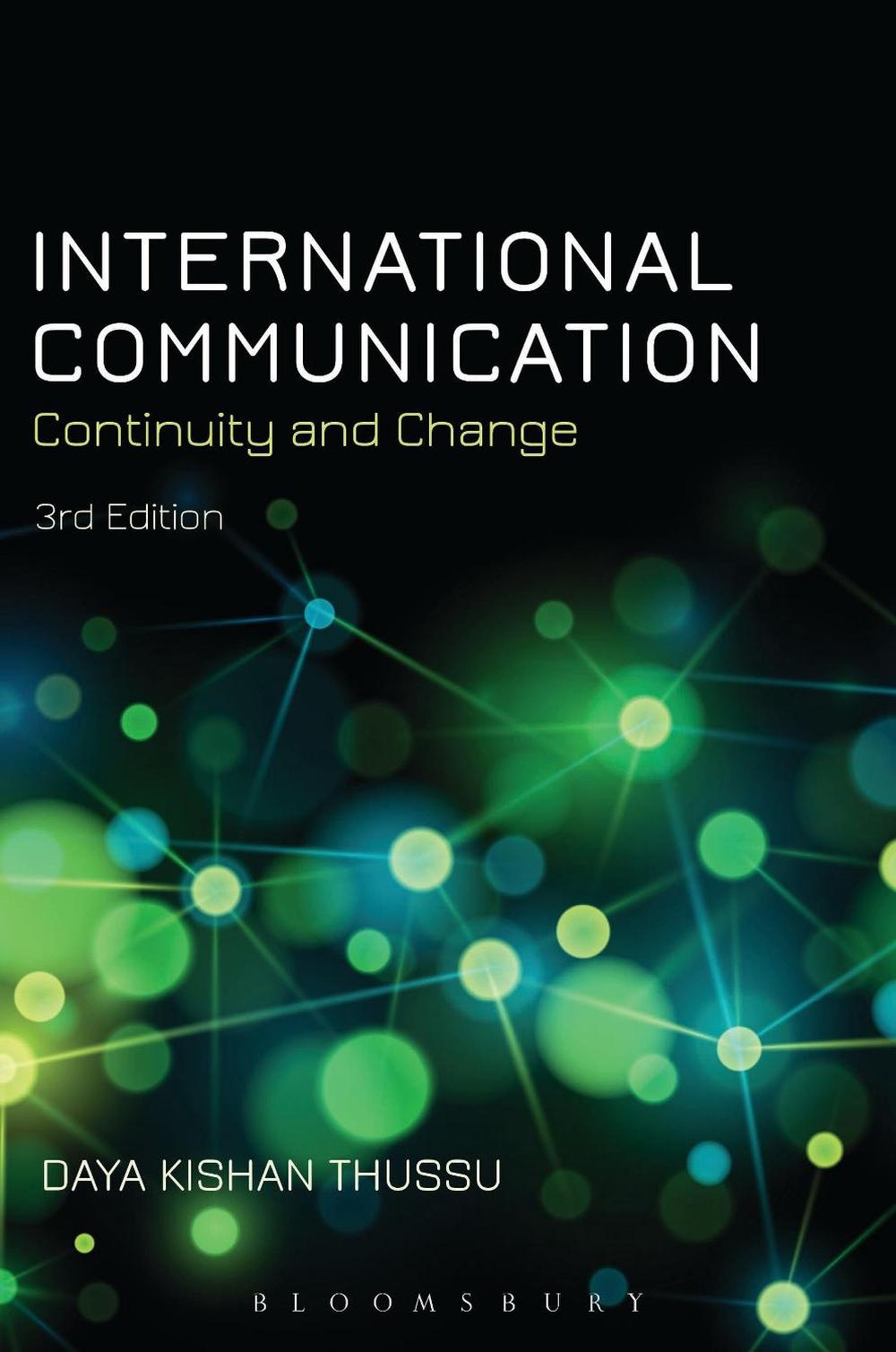
When you click on links to various merchants on this site and make a purchase, this can result in this site earning a commission. Affiliate programs and affiliations include, but are not limited to, the eBay Partner Network.
International Communication: Continuity and Change by Daya Kishan Thussu (Englis

- Item No : 157023824848
- Condition : Brand New
- Brand : No brand Info
- Seller : the_nile
- Current Bid : US $58.34
-
* Item Description
-
The Nile on eBay

International Communication
by Daya Kishan Thussu
This bestselling text is a unique introduction to the complex political, economic and technological context in which multinational media and culture operates. With new case studies and pedagogical features, the book is compulsory reading for all media and communication studies students.
FORMAT
PaperbackLANGUAGE
EnglishCONDITION
Brand New
Publisher Description
The third edition of International Communication examines the profound changes that have taken place, and are continuing to take place at an astonishing speed, in international media and communication.
Building on the success of previous editions, this book maps out the expansion of media and telecommunications corporations within the macro-economic context of liberalisation, deregulation and privitisation. It then goes on to explore the impact of such growth on audiences in different cultural contexts and from regional, national and international perspectives. Each chapter contains engaging case studies which exemplify the main concepts and arguments.Table of Contents
Introduction to the Third Edition
Chapter 1: The Historical Context of International Communication
Communication and Empire
The Growth of the Telegraph
The Era of News Agencies
Case Study: The Rise of Reuters
The Advent of Popular Media
Radio and International Communication
The Cold War – From Communist Propaganda to Capitalist Persuasion
Case Study: Covert Communication – RFE and RL
International Communication and Development
Case Study: Satellite Instructional Television Experiment
The Demand for a New World Information and Communication Order
Chapter 2: Approaches to Theorizing International Communication
'Free Flow of Information'
Modernization Theory
Dependency Theory
Structural Imperialism
Hegemony
Critical Theory
The Public Sphere
Cultural Studies Perspectives on International Communication
Theories of the information society
Discourses of Globalization
A Critical International Communication Theory?
International Communication in International Politics
Internationalizing International Communication Theory
Chapter 3: Creating a Global Communication Infrastructure
The Privatization of Telecommunications
Free Trade in Communication Products and Services
Liberalization of the Telecom Sector
Privatizing Space – the Final Frontier
Case Study: Intelsat
The Global Satellite Industry
Regional Satellite Services
The Globalization of Telecoms
Infrastructure for Internet
Who Controls the Internet Infrastructure?
Regulating an unregulated global Communication market
The 'T-treaty Trinity' and Further Digital Deregulation?
Implications of a Liberalized Global Communication Regime
Chapter 4: The Global Media Market
Convergence
Global Media Conglomerates
Case Study: Murdoch: A Global Media Mogul
Televising Sport Globally
Global News and Information Networks
Case Study: CNN – The 'World's News Leader'
Setting the Global News Agenda
Chapter 5: The Global and the Local in Media Cultures
The Globalization of American Consumer Culture
Global Trade in Media Products
Public service to Private Profit – European Broadcasting
Case Study: Children's Television – Catching Them Young
Hollywood Hegemony
Concerns for cultural Diversity
Global English
Regionalizing and Localizing Media Cultures
Global Music
Case Study: MTV
Adaptation, Hybridity or Hegemony?
Cultural Relativism and Revivalism
Culture as 'Soft Power'
Chapter 6: Contraflow in Global Media
The Globalization of China's Media
Contraflow in Global Entertainment
The Other Hollywood – The Indian Film Industry
Case Study: Zee TV – The Globalization of Indian Entertainment
Globalization of Geo-linguistic Television
The Transnationalization of Telenovelas
Case Study: The Dramatic Rise of Turkish TV Dramas
Case Study: Hallyu – the Korean Wave
Case Study: Nigerian cinema Goes Global – Nollywood
Contraflow in Global TV News
Case Study: Al Jazeera – The 'Island' that Became a Global News Phenomenon
The 'RT Effect'
Contra or Complementary Flows?
Cultures of Diaspora and 'Migratory' Media
Chapter 7: International Communication in the Digital Age
Digital Capitalism and a 'Free Flow of Commerce'
Case Study: The 'Googlization' of Global Communication
The Facebook Effect
Communicating 'Cyber-Capitalism with Chinese Characteristics'
Internet and Political Communication
Case Study: The Globalization of 'Fake News'
How the Web Has Affected Journalism
International Communication as Infotainment and Edutainment
Case Study: Infotainment 2.0
Global Edutainment
Governance and Regulation in the Digital Age
Global Communication: covert Spying and Overt Surveillance
Communication for Development
The 'Chindia' Effect
Internationalizing International Communication Studies
International Communication: Continuity and Change
Glossary
Appendix I: A Chronology of International Communication
Appendix II: Useful Websites
Appendix III: Discussion Questions
References
IndexReview
Daya Thussu's International Communication is an excellent introduction to global media or international communication. It has excellent historical analysis, somewhat focused on the British Empire and its colonies, but quite comprehensive. It covers all the major issues well and is quite comprehensive. while also being very readable. It uses key case studies well and should intrigue both students new to the subject, as well as more advanced readers. * Joseph Straubhaar, Amon G. Carter, Sr. Centennial Professor of Communication, University of Texas at Austin, USA *
In this time of major transformations, contentions and challenges, understanding and conducting international communication is more critical than ever. Thussu's third edition presents the reader with an extraordinarily prescient and penetrating perspective on international communication and its complex contexts. With its vibrant case studies, it is must reading for policymakers and practitioners as well as students. * Nanette S. Levinson, Faculty Director, Internet Governance Lab, School of International Service, American University, USA *
This book is an outstanding combination of historical analysis, factual data and coverage of current trends in global media. The research contributes to deeper understanding of media in many regions and countries across the world, which makes Daya Thussu's book a valuable input into global research of media and communications. * Elena Vartanova, Professor, Dean, Faculty of Journalism, Lomonosov Moscow State University, Russia *Promotional
With new case studies and pedagogical features, this bestseller is compulsory reading for all media and communication studies students.
Long Description
The third edition of International Communication examines the profound changes that have taken place, and are continuing to take place at an astonishing speed, in international media and communication. Building on the success of previous editions, this book maps out the expansion of media and telecommunications corporations within the macro-economic context of liberalisation, deregulation and privitisation. It then goes on to explore the impact of such growth on audiences in different cultural contexts and from regional, national and international perspectives. Each chapter contains engaging case studies which exemplify the main concepts and arguments.
Review Quote
This book is an outstanding combination of historical analysis, factual data and coverage of current trends in global media. The research contributes to deeper understanding of media in many regions and countries across the world, which makes Daya Thussu's book a valuable input into global research of media and communications.
Promotional "Headline"
With new case studies and pedagogical features, this bestseller is compulsory reading for all media and communication studies students.
Feature
Daya Kishan Thussu is the leading figure Global Media Communication
Details
ISBN1780932650Author Daya Kishan ThussuLanguage EnglishEdition 3rdISBN-10 1780932650ISBN-13 9781780932651Media BookFormat PaperbackImprint Bloomsbury AcademicSubtitle Continuity and ChangePlace of Publication LondonCountry of Publication United KingdomDEWEY 302.23Short Title INTL COMMUNICATION REV/E 3/EYear 2018Affiliation Winchester College, UKPosition Classics TeacherUK Release Date 2018-12-27Publication Date 2018-12-27NZ Release Date 2018-12-27Illustrations 45 bw illusEdited by Claire WebsterBirth 1984Qualifications R.N., B.S.N., OcnPages 392Publisher Bloomsbury Publishing PLCEdition Description 3rd editionAudience Tertiary & Higher EducationAU Release Date 2018-12-26


















